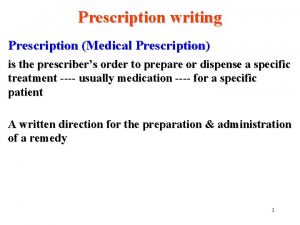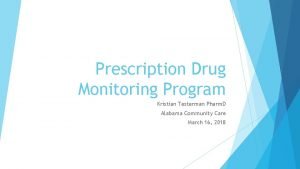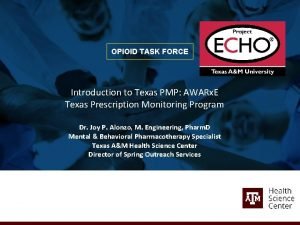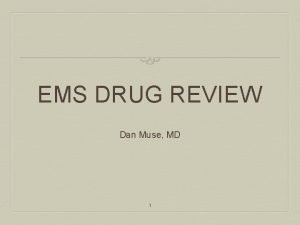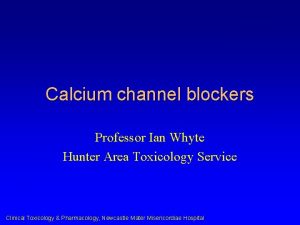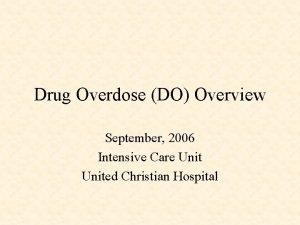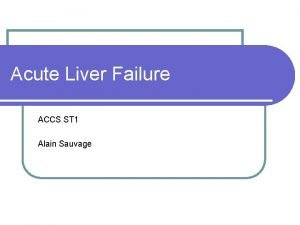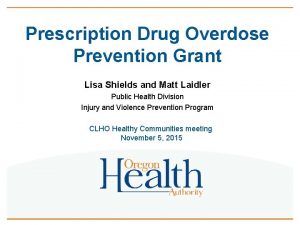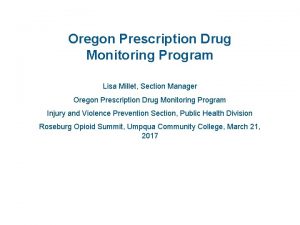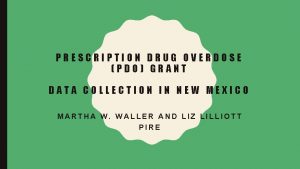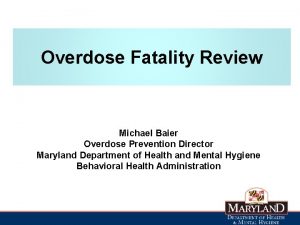Prescription Drug Overdose Prevention Grant Lisa Millet and












- Slides: 12

Prescription Drug Overdose Prevention Grant Lisa Millet and Matt Laidler Public Health Division Injury and Violence Prevention Program CLHO meeting December 17, 2015

Topics covered • • 2 The burden of prescription drug overdose Overview of the CDC Prevention Grant for States Plan and selection process for regional funding Program element and next steps

Prescription Opioids: The Problem • In Oregon, over 2, 400 people have died from overdoses associated with prescription opioids since 1999 • Results from the 2012 -2013 National Survey on Drug Use and Health tie Oregon for 2 nd place among all US states in non-medical use of prescription pain relievers • In 2013, 3. 6 million prescriptions for opioid painkillers were dispensed in Oregon, enough for 925 opioid prescriptions for every 1, 000 residents in that year alone 3

CDC Prevention Grant • Oregon is one of 16 states selected for CDC Prescription Drug Overdose: Prevention for States funding for 2015 -2019, to advance prevention in four key areas: – Enhancing and Maximizing State Prescription Drug Monitoring Programs (PDMPs) – Implementing Community or Insurer/Health Systems Interventions – Conducting Policy Evaluations – Developing and Implementing Rapid Response Projects 4

5

Driver Diagram: PDO Prevention, 2015 - 2019 Aim Primary Drivers Reduce problematic prescribing practices Reduce deaths, hospitalizations, and emergency department visits related to drug overdose Increase access to and reimbursement for nonopioid treatments for chronic non-cancer pain Provide Medication Assisted Treatment (MAT) for opioid use disorder Increase and improve the infrastructure of naloxone rescue Use data to target interventions to populations at highest risk Staff Katrina Hedberg, State Health Officer Lisa Millet, Principal Investigator Lisa Shields, Program Coordinator Matt Laidler, Research Analyst Josh van Otterloo, Research Analyst Secondary Drivers 1. Implement opioid prescribing guidelines for pain management ü Engage CCOs, Emergency Departments, health systems, pharmacies, and insurers to expand uptake and use of evidence-based opioid prescribing and management guidelines ü Fund five high- burden county regions to form and convene regional pain guidance groups (PGGs) and interdisciplinary action teams (IATs) to expand uptake of model opioid prescribing guidelines 2. Enhance and maximize the Oregon Prescription Drug Monitoring Program (PDMP) ü Reduce barriers and increase PDMP registration and use ü Reduce data reporting interval ü Increase PDMP reporting, surveillance, and data sharing ü Establish messaging to PDMP users ü Authorize PDMP to share identified data with researchers, public health, and health systems 3. Provide reimbursement for non-opioid pain treatment therapies ü Require insurers to pay for non-opioid care for chronic non-cancer pain treatment ü Encourage CCOs and other prescribers to increase the use of non-opioid pain management 4. Increase the number and geographic distribution of primary care physicians certified to provide MAT for chronic opioid dependency 5. Increase access to naloxone ü Establish a standing order for Naloxone distribution at pharmacies ü Increase access to Naloxone through community-based programs ü Include co-prescribing of naloxone in model guidelines when prescribing opioids for at-risk patients 6. Evaluations of policy and programs ü Evaluate the public health impact of removing methadone as a preferred pain treatment drug from the state Medicaid drug formulary ü Evaluate the impact of 72 -hour or “real time” PDMP reporting

State “hot spots” • Aim: fund five high- burden county regions to form and convene regional pain guidance groups (PGGs) and interdisciplinary action teams (IATs) to expand uptake of model opioid prescribing guidelines • Jim Shames and Laura Heesacker (Jackson County) are consultants for this effort

Funding for 5 regions • Years 1 -2 Multnomah, Clackamas, Washington v. Lane, Douglas v. Coos, Curry, Josephine v • Years 3 -4 Clatsop, Tillamook v. Lincoln, Linn, Benton v

Selection • Index measure/composite score of 5 factors: 1) county rate of opioid overdose death, 2) county rate of opioid overdose hospitalization, 3) rate (per 1, 000 residents) of prescribing for all opioids, 4) average # patients per month with > 100 MED prescriptions, 5) county population • Factors weighted according to importance for reducing aggregate overdose rates and problematic prescribing rates • Counties were assigned points by their rank of these factors (e. g. the county that had the highest overdose death rate received 25 points, the next highest, 24, etc. ) • Composite score = averaged county factor scores across five factors [no single factor alone disproportionately contributed to composite score]. • Selected counties are a mix of large and small (population), but each with sizable overdose and/or problematic prescribing rates

Program Element highlights $95, 500 annually for a PDO coordinator in each region who will: • Complete remote (web-based) training on using the Oregon Prescription Drug Monitoring Program (PDMP) and PDMP guidelines. • Promote prescriber enrollment and adoption of the PDMP • Accomplish movement toward building or strengthening a community network within the region • Convene or strengthen an existing Interdisciplinary Action Team (IAT), a Pain Guidance Group (PGG), and a regional summit • Disseminate local data or stories to local media outlets to promote public awareness of the burden and preventability of PDO

Next steps • December 18 – The approved PE will be sent to OHA Contracts for processing. • OHA will develop templates for budget and work plan • PE included in the January amendment • OHA will host phone calls in January with each region and the project team to discuss next steps

Contact Information Lisa Shields Lisa. m. shields@state. or. us Matt Laidler Matthew. laidler@state. or. us Lisa Millet Lisa. m. millet@state. or. us 12
 Primary prevention secondary prevention tertiary prevention
Primary prevention secondary prevention tertiary prevention How to write drug prescription
How to write drug prescription Alabama prescription drug monitoring program
Alabama prescription drug monitoring program Tx pmp
Tx pmp International standards on drug use prevention
International standards on drug use prevention Exhausted drug
Exhausted drug Vitamin b6 overdose
Vitamin b6 overdose Tricyclic antidepressants overdose
Tricyclic antidepressants overdose Magnesium overdose
Magnesium overdose Beta-blocker overdose treatment glucagon
Beta-blocker overdose treatment glucagon Glucagon for beta blocker overdose
Glucagon for beta blocker overdose Zoplicone overdose
Zoplicone overdose Hepatic encephalopathy staging
Hepatic encephalopathy staging

